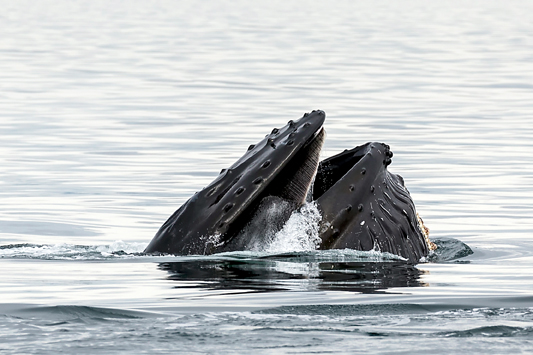PORT ANGELES — It’s “humpback heaven” in the Strait of Juan de Fuca, whale watchers say.
The Pacific Whale Watch Association is reporting unprecedented numbers of humpback whales in recent weeks, particularly off the shores of Port Angeles and Victoria.
Whale-watching crews are seeing large groups of extremely active humpbacks — as many as 15 or 20 together — in the inland waters of the Salish Sea.
“In 20 years of running whale-watch tours, I’ve never seen anything like what’s happening right now in Port Angeles,” said Capt. Shane Aggergaard of Port Angeles Whale Watch Co.
“This is truly world-class whale watching.
“We’ve never seen so many humpback whales in the central straits, and it shows no signs of stopping,” Aggergaard added in a news release.
“I expect these sightings to continue well into the fall.”
North Pacific humpback whales have been making a comeback in the past few years after being threatened by commercial whaling, which was banned in 1966, according to the Pacific Whale Watch Association.
The surge in inland-waters sightings this year has taken the “humpback comeback” to a new level, officials said.
“It’s humpback heaven out there right now,” said Michael Harris, Pacific Whale Watch Association executive director.
“About 20 years ago or so, we never saw humpback whales out there. The last three or four years, our crews started to see them all the time.
“Now we’re seeing them congregate in these large groups, not unlike what you might see in Hawaii or Alaska,” Harris added.
“One humpie after another, just an expanse of whales filling the seascape.”
The Pacific Whale Watch Association represents 38 whale-watching and ecotourism companies operating out of 21 ports in Washington and British Columbia.
Behemoth humpback whales can be seen breaching, rolling, slapping their pectoral fin and going on feeding frenzies.
“They definitely seem to be finding plenty to eat, especially off Port Angeles and Victoria, and that may be a good sign,” Harris said.
Scientists say humpback populations in the northeast Pacific have climbed from about 1,600 in 1966 to more than 21,000 today.
A combination of the whaling ban and an abundance of prey is contributing to the recent spate in humpback sightings, experts say.
“Humpback whales have made a dramatic return to the Salish Sea in recent years and especially this year,” said John Calambokidis, senior research biologist and co-founder of the Cascadia Research Collective.
“We’ve had lots of humpback whales offshore in past years and now more of them are coming into the inland waters.
“That’s probably due to the increased numbers overall likely resulting in expanded areas of use, but also something to do with prey availability, which at this point is harder to determine in detail.”
The Salish Sea includes the Strait of Juan de Fuca, Strait of Georgia and Puget Sound, as well as their connecting channels and adjoining waters.
Humpback whales typically visit the Pacific Northwest from spring to fall before migrating south to warm-water breeding and calving grounds in Mexico, Central America and Hawaii.
Rhonda Reidy, a naturalist, marine educator and captain for the Victoria-based Prince of Whales Whale Watching, said the humpback population might be nearing its carrying capacity in northern feeding areas.
The recent population boom might also represent shifts in oceanographic and ecological conditions that affect the food chain, Reidy said in a Tuesday news release.
Sightings of Southern Resident orcas have been more sparse this year than other years, wildlife officials have said, attributing that to changes in the ecosystem, primarily in the availability of their food, salmon, wildlife officials said.
Humpbacks are largely foragers that feed on krill and small schooling fish such as sardine, anchovy and herring.
“The high degree of foraging flexibility may be why humpback whales are doing so well,” Reidy said.
________
Reporter Rob Ollikainen can be reached at 360-452-2345, ext. 56450, or at rollikainen@peninsuladailynews.com.

